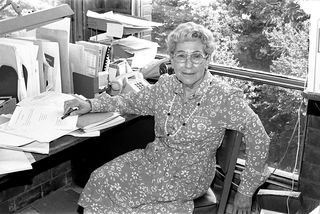 This month marks three years since the late Mildred Cohn, PhD, the Benjamin Rush Professor Emerita of Physiological Chemistry at the time of her retirement from the Penn department of Biochemistry and Biophysics, passed away. Her early work using magnetic forces to study the structure of molecules led to the development of modern day magnetic resonance imaging, a mainstay of medical research and practice.
This month marks three years since the late Mildred Cohn, PhD, the Benjamin Rush Professor Emerita of Physiological Chemistry at the time of her retirement from the Penn department of Biochemistry and Biophysics, passed away. Her early work using magnetic forces to study the structure of molecules led to the development of modern day magnetic resonance imaging, a mainstay of medical research and practice.
Ever since I watched the video about her life from the new Chemical Heritage Foundation’s series Women in Chemistry, I have thought each time I read a new article about gender and science, “What would Dr. Cohn think?”
What would she have to say about a new study out this week showing that the percentage of women authors on journal articles is at its highest ever – 30 percent, but women are still less likely to be the first or last author. Cohn herself published 160 scientific papers, including several that she co-authored with six different Nobel Laureates.
Then there’s this article in Nature describing an edit-a-thon to get more women scientists into Wikipedia. On October 19, the 3.5-hour session, hosted by the Royal Society in London, improved and added online entries for female scientists, engineers, and mathematicians. The editors worked from a wish list of almost 200 women.
Cohn’s Wikipedia entry is 11 lines. Funnily enough, her entry was updated on October 16, which is Ada Lovelace Day, a celebration of female scientists, named after the 19th century pioneer of computer programming.
I wonder what Dr. Cohn would make of all of this – a chemist who, according to her obituary in the New York Times, “achieved success only after repeatedly encountering prejudice, from the college professor who told her that being a chemist would not be ‘ladylike’ to chemical company recruiters who explicitly refused to interview women or Jews, to university departments that would not allow a woman on the track to be a tenured professor. She had to wait 21 years after receiving her Ph.D. to receive her first tenure-track appointment.”
Nevertheless, female scientist superlatives dot her resume. She was the first woman to be appointed to the editorial board of the Journal of Biological Chemistry. She was the first woman to become president of the American Society for Biochemistry and Molecular Biology (ASBMB) and also the first female career investigator for the American Heart Association. She recounts this part of her life in a video interview as part of the history of the ASBMB. She was also awarded a National Medal of Science.
Josh Wand, PhD, the Benjamin Rush Professor of Biochemistry & Biophysics at Penn and a former student of Cohn's, wrote in an email to The Scientist for her obituary: "She surmounted great structural barriers [for women] and was essentially forced to work outside jobs to pay for equipment and chemicals during her PhD." She was one of the first to take meaningful pictures of proteins using nuclear magnetic resonance, Wand said, and applied this technique to a variety of biochemical problems, such as the mechanisms of enzymes.
Even after she “retired,” Cohn was living large: She celebrated her 90th birthday by hang gliding.
Next time there’s a call for updating female scientists on Wikipedia, I reserve a spot for Mildred Cohn on my wish list.